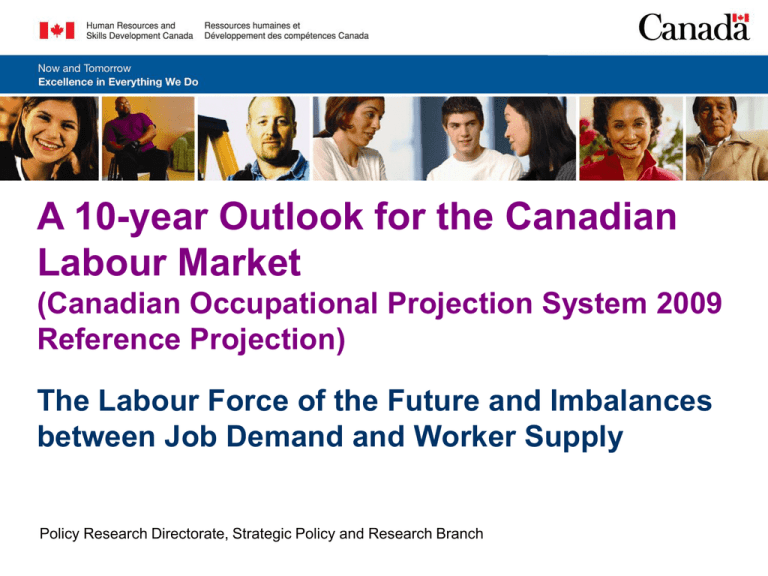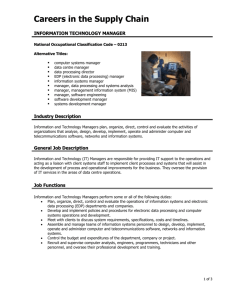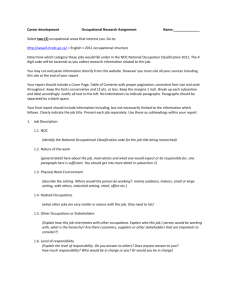A 10-year Outlook for the Canadian Labour Market Reference Projection)
advertisement

A 10-year Outlook for the Canadian
Labour Market
(Canadian Occupational Projection System 2009
Reference Projection)
The Labour Force of the Future and Imbalances
between Job Demand and Worker Supply
Policy Research Directorate, Strategic Policy and Research Branch
Overview
Presentation on Labour Demand: Key Conclusions
Labour Supply
– Labour Force
– School Leavers
– Immigration
Imbalances
– by Broad Skill Level
– by Occupation
– Mismatch between Field of Study and Occupation
2
Presentation on Labour Demand:
3
Retirements will account for most of the job openings
Job Openings from Expansion Demand and Replacement Demand, 1996-2018
800,000
Projection
700,000
600,000
500,000
400,000
300,000
200,000
100,000
0
-100,000
Expansion Demand
Retirements
Other Replacement Demand*
-200,000
-300,000
-400,000
1996
1998
2000
2002
2004
2006
2008
Source: Policy Research Directorate, HRSDC (Reference Scenario 2009).
* Other Replacement Demand Includes Deaths and Emigration
2010
2012
2014
2016
2018
4
Two-thirds of all job openings will be in occupations
usually requiring PSE or in management occupations
Thousands
Job Openings from Expansion Demand and Replacement Demand by Skill Level,
(2009-2018)
2,000
Expansion Demand
1,800
Replacement Demand (Retirements)
1,600
Replacement Demand (Deaths and
Emigration)
1,400
32.9%
2 out of 3 job openings in occupations
usually requiring PSE or in management
25.6%
22.7%
1,200
1,000
800
11.2%
600
7.7%
400
200
0
Management
University
College
Source: Policy Research Directorate, HRSDC (Reference Scenario 2009).
High School
On-the-job
Training
5
Labour Supply
6
Labour force growth is projected to slow over the next
decade
Growth of Labour Force 15+ (Non-Student), 1999-2018
(%)
(1999-2008): 1.7% average
growth
450
(2009-2018): 0.8% average growth
Reference Scenario 2009
400
2,5
350
2,0
300
Thousands
3,0
250
1,5
200
1,0
150
100
0,5
50
0,0
0
1999
2008
2005
2002
Labour Force Changes, 000s (Left Axis)
2017
2014
2011
Annual Growth, % (Right Axis)
Sources: Statistics Canada and Policy Research Directorate, HRSDC (Reference Scenario 2009).
7
Labour force growth is projected to slow over the next
decade
Growth of Labour Force 15+ (Non-Student), 1999-2017
(%)
(1999-2007): 1.7% average
growth
450
(2008-2017): 0.9% average growth
400
Reference Scenario 2008
Thousands
350
3.0
2.5
Main difference between Reference 2008 and 2009
300
2.0
250
1.5
200
150
1.0
100
0.5
50
0
0.0
1999
2002
2005
2008
Labour Force Changes, 000s (Left Axis)
2011
2014
2017
Annual Growth, % (Right Axis)
Sources: Statistics Canada and Policy Research Directorate, HRSDC (Reference Scenario 2008).
8
10-Year Outlook
forbethe
Canadian
Labour Market
Population
growth will
somewhat
slower
Population 15+ (Non-student): Annual Growth Rate, 1999-2018
2.0
Population Growth Rate (%)
1.8
Average (%)
Forecast
1.6
1.4
1.2
1.0
0.8
0.6
Average growth rate over 1999-2008: 1.40%
Average growth rate over 2009-2018: 1.17%
0.4
0.2
0.0
1999 2000 2001 2002 2003 2004 2005 2006 2007 2008 2009 2010 2011 2012 2013 2014 2015 2016 2017 2018
Sources: Statistics Canada and Policy Research Directorate, HRSDC (Reference Scenario 2009).
9
Labour force participation rates by age group are projected
to increase further
Labour Force Participation Rates for Age Groups 25-54 and 55-64, 1990-2018
(%)
Forecast
90
85
25-54
80
75
70
65
60
55
55-64
50
45
40
1990
1992
1994
1996
1998
2000
2002
2004
2006
2008
2010
2012
2014
Sources: Statistics Canada and Policy Research Directorate, HRSDC (Reference Scenario 2009).
2016
2018
10
Nevertheless,
rapid increases
in the share
of 55+ Market
10-Year Outlook
for the Canadian
Labour
population will pull down the aggregate participation rate
Share of Age Group 55+ in Total Population (Non-Student), 1990-2018
Forecast
45%
40%
35%
30%
25%
20%
15%
10%
5%
0%
1990
1992
1994
1996
1998
2000
2002
2004
2006
2008
2010
2012
Sources: Statistics Canada and Policy Research Directorate, HRSDC (Reference Scenario 2009).
2014
2016
2018
11
10-Year
Outlook
for the
theaggregate
Canadianlabour
Labour
Market
Due
to population
aging,
force
participation rate will start to decline in the next few years
Labour Force Participation Rate, Total and by Gender (15+, Non-Student), 1976-2018
(%)
85
Forecast
80
Males
75
70
Total
65
60
55
Females
50
45
40
1976
1979
1982
1985
1988
1991
1994
1997
2000
2003
2006
2009
Sources: Statistics Canada and Policy Research Directorate, HRSDC (Reference Scenario 2009).
2012
2015
2018
12
Projection Models - Structure
Demographic and Macroeconomic Projections
Employment
Labour Force
outflows
Expansion
Demand
Replacement
Demand:
- Retirements
- Emigrants - Deaths
Labour Demand
intra-flows
inflows
Job Seekers:
Net Mobility
- School leavers
- Immigrants
- Net reentrants
Labour Supply
Future Labour Market Imbalances
by Broad Skill Level
Future Labour Market Imbalances
by Occupation
Change in employment versus
change in labour force by broad skill level
Labour demand versus labour supply
by occupation
13
Youth population (15-29) will increase in the next decade,
thus more youth are expected to enter the labour market
Population 15-29 in ‘000s and as a Share of Total Population: 1971-2018
(%) 35
Babyboom: Born between
1947 and 1966
1999-2008
Average youth
population: 6.49M
30
Average youth
population: 6.77M
Echoboom: Born
from late 70's to
late 80's
20
6,500
6,000
Population 15-29
(right axis)
15
7,000
Thousands
25
7,500
2009-2018
Share of population
15-29 (left axis)
10
5,500
5,000
1971 1974 1977 1980 1983 1986 1989 1992 1995 1998 2001 2004 2007 2010 2013 2016
Sources: Statistics Canada and Policy Research Directorate, HRSDC (Reference Scenario 2009).
14
Most youth entering the labour market will come from PSE
programs as the enrolment rate will trend up
Enrolment Rates in University Programs as a Percentage of Source Population, 19912018
Projection
30.0%
25.0%
0.70%
0.60%
PhD (Right Axis)
0.50%
20.0%
Ba. and First professional (Left
Axis)
0.40%
15.0%
College (left Axis)
10.0%
Master’s (Left Axis)
0.30%
0.20%
5.0%
0.10%
0.0%
0.00%
1991 1993 1995 1997 1999 2001 2003 2005 2007 2009 2011 2013 2015 2017
Sources: Statistics Canada and Policy Research Directorate, HRSDC (Reference Scenario 2009).
15
The recession is expected to have a positive impact on
enrolments in PSE programs
First-Year Enrolments in Postsecondary Education: Impact of Recession
('000s)
Colleges: Recession
Projection
400
Recession
380
360
Colleges: No Recession
340
University: Recession
320
300
280
University: No Recession
260
240
Double cohort
220
200
2000
2003
2006
2009
2012
2015
2018
Sources: Statistics Canada and Policy Research Directorate, HRSDC (Reference Scenario 2009).
16
Students who enrolled during the recession will enter the
labour market during the economic recovery
School Leavers from Postsecondary Education: Impact of Recession
Projection
('000s) 185
College_Recession
Recession
College_No Recession
165
University_Recession
145
University_No Recession
125
105
2000
2003
2006
2009
2012
2015
Sources: Statistics Canada and Policy Research Directorate, HRSDC (Reference Scenario 2009).
2018
17
The number of school leavers with less than high school is
projected to decline by a third over the next 10 years
School Leavers with Less than High School Education, 1990-2018
300
Population 14-18
250
1000
200
800
150
600
100
400
Reference 2009
50
200
Population 14-18, ‘000s
Less than High School, '000s
1200
Projection
Double cohort
0
0
1990
1993
1996
1999
2002
2005
2008
2011
2014
Sources: Statistics Canada and Policy Research Directorate, HRSDC (Reference Scenario 2009).
2017
18
The high school dropout rate is also projected to resume a
downward trend
High School Dropouts, 1975-2018
25%
250
Dropouts (Right Axis)
210
20%
Dropout Rate
230
190
170
15%
150
130
110
10%
90
70
5%
High School Dropouts, '000s
Projection
Dropout Rates (Left Axis)
50
1975
1979
1983
1987
1991
1995
1999
2003
2007
2011
Sources: Statistics Canada and Policy Research Directorate, HRSDC (Reference Scenario 2009)
2015
19
The number of school leavers with a high school degree is
projected to increase marginally over the next ten years
Projection
300
3500
Population 18-24
3000
250
2500
200
Reference 2009
2000
Double
cohort
Double
cohort
150
1500
100
1000
50
Population 18-24, ‘000s
School Leavers with a High School Degree, '000s
School Leavers with a High School Degree Only, 1990-2018
500
0
0
1990
1993
1996
1999
2002
2005
2008
2011
2014
Sources: Statistics Canada and Policy Research Directorate, HRSDC (Reference Scenario 2009).
2017
20
The number of school leavers with a college degree is
projected to increase by 15% over the next ten years
School Leavers with a College Degree, 1990-2018
Population 18-24
300
3500
3000
250
2500
200
2000
Reference 2009
150
1500
Double cohort
100
1000
50
Population 18-24, ‘000s
School Leavers from College Programs, '000s
Projection
500
0
0
1990
1993
1996
1999
2002
2005
2008
2011
2014
Sources: Statistics Canada and Policy Research Directorate, HRSDC (Reference Scenario 2009).
2017
21
The number of school leavers with a university degree is
projected to increase by 15% over the next ten years
School Leavers with a University Degree, 1990-2018
300
5000
Population 20-29
250
4500
200
4000
Reference 2009
150
3500
100
3000
Double cohort
50
2500
0
2000
1990
1993
1996
1999
2002
2005
2008
2011
2014
Sources: Statistics Canada and Policy Research Directorate, HRSDC (Reference Scenario 2009).
Population 20-29, ‘000s
School Leavers from University Programs, '000s
Projection
2017
22
The share of school leavers with a postsecondary
education will increase over the next ten years
School Leavers by Education Level, 1999-2008 and 2009-2018
4,000,000
Less than High School
High School or Some PSE
College
University
3,500,000
69.4%
3,000,000
66.7%
2,500,000
2,000,000
1,500,000
31.6%
33.3%
1,000,000
500,000
0
1999-2008
2009-2018
Sources: Statistics Canada and Policy Research Directorate, HRSDC (Reference Scenario 2009).
23
The younger cohorts entering the labour market are more
educated than the older ones but the gap is narrowing
Share of the Labour Force (Non-Student) with Postsecondary Education by Age Group,
1990-2018
(%) 80
55-64 years old
25-29 years old
Projection
70
Gap in
2018: 8.1%
Gap in 2008: 9.8%
60
50
Gap in
1990: 15.8%
40
30
20
1990
1993
1996
1999
2002
2005
2008
2011
2014
Sources: Statistics Canada and Policy Research Directorate, HRSDC (Reference Scenario 2009).
2017
24
As
a result,Outlook
the level of
attainment
of Canada’s
10-Year
foreducational
the Canadian
Labour
Market
labour force will continue to rise, but at a slower pace
Share of Labour Force (25+, Non-Student) with a Postsecondary Education, 1990-2018
70%
Projection
65%
60%
55%
50%
45%
40%
35%
30%
1990 1992 1994 1996 1998 2000 2002 2004 2006 2008 2010 2012 2014 2016 2018
Sources: Statistics Canada and Policy Research Directorate, HRSDC (Reference Scenario 2009).
25
Immigration
will playfor
a smaller
role than school
leavers
as
10-Year Outlook
the Canadian
Labour
Market
a source of new job seekers
Sources of New Job Seekers: School Leavers and Immigration (15+, Non-Student) 19972018
Projection
Immigration
School Leavers
600,000
500,000
400,000
300,000
200,000
100,000
0
1997
1999
2001
2003 2005
2007
2009
2011 2013
Sources: Statistics Canada and Policy Research Directorate, HRSDC (Reference Scenario 2009).
2015
2017
26
An increasing share of new immigrants in the labour force
have postsecondary education
Recent Immigrants (last 5 years) by Education Level, 2001 and 2006
400,000
Less than High School
High School or Some PSE
College
350,000
University
73.7%
300,000
65.3%
250,000
200,000
150,000
34.7%
26.3%
100,000
50,000
0
2001
Sources: Statistics Canada, Census 2001 and 2006.
2006
27
The match between the level of education and the skill level
usually required by employers is not perfect
Proportion of the Labour Force with a Given Level of Education by Skill Level, Amongst
Population 25-29, 2008
Management
Occupations usually requiring
Occupations usually requiring
Occupations usually requiring
Occupations usually requiring
100%
university education
college education or apprenticeship training
high school
only on-the-job training
5.4%
10.7%
6.7%
90%
6.8%
5.9%
80%
70%
4.9%
1.6%
31.4%
35.3%
50.6%
46.6%
60%
50%
39.4%
40%
30%
37.7%
23.3%
31.1%
20%
10%
16.2%
3.2%
0%
University
6.2%
College
14.3%
High school
Sources: Statistics Canada and Policy Research Directorate, HRSDC (Reference Scenario 2009).
22.7%
Less than High school
28
Over six in ten job seekers will offer their services in highskill occupations over the next ten years
Job Seekers by Skill Level, 2009-2018
Job Seekers (in '000s)
2000
1500
Other
Immigrants
School Leavers
29.7%
30.0%
21.5%
1000
7.9%
10.9%
500
0
-500
Management
University
College
High School
On-the-job Training
Sources: Statistics Canada and Policy Research Directorate, HRSDC (Reference Scenario 2009).
29
Imbalances
30
There is limited evidence of imbalances between demand
and supply by broad skill level in recent decades
Relative Unemployment Rates (left chart) and Relative Wages (right chart) by Skill Level
%
300
%
Management
Occupation usually requiring university education
Occupation usually requiring college education or apprenticeship training
Occupation usually requiring high school education
Occupation requiring only on-the-job training
250
300
Management
Occupation usually requiring university education
Occupation usually requiring college education or apprenticeship training
Occupation usually requiring high school education
Occupation requiring only on-the-job training
250
200
200
150
150
100
100
50
50
0
0
1990
1992
1994
1996
1998
2000
2002
2004
Sources: Statistics Canada, Labour Force Survey
2006
2008
1990
1992
1994
1996
1998
2000
2002
2004
2006
31
2008
Small
gaps between
demand
by skill level
over the
medium
10-Year
Outlook
for and
thesupply
Canadian
Labour
Market
term but recession leads to excess supply conditions in the short run
Job Openings and Job Seekers by Skill Level, as a Percentage of 2008 Employment,
Outlook for the Next Two Years (2009-2010) and Ten Years (2009-2018)
6.0
Projection Periods
Job Openings (%)
Openings
JobJob
Openings
in in
Excess
of Job
Excess
of Job
Seekers
5.0 Seekers
2009-2010
2009-2018
Occupations
Usually Requiring
University
4.0
Management
Occupations Usually
Management
Requiring College or
Apprenticeship
3.0
Occupations Usually
Requiring High School
Occupations Usually
2.0
Occupations
Usually
Requiring
On-the-Job
Training
Requiring
College or
Apprenticeship
Source: Policy Research
Directorate, HRSDC
(Reference Scenario 2009).
1.0
Job Seekers in
Excess of Job
Openings
0.0
0.0
1.0
2.0
Job Seekers (%)
3.0
4.0
5.0
6.0
32
However,
the medium
several occupations
will be
10-YearinOutlook
for term,
the Canadian
Labour Market
facing shortage or surplus conditions
Job Seekers and Job Openings by Occupation (3-digit), as % of 2008 Employment,
Ex-Post Scenario
9
High Skill
8.5
Low Skill
8
Balance
Excess Demand
7.5
Excess demand
In balance
7
6.5
NOC 031
Job Openings (%)
6
NOC 315
5.5
CNP 311
5
4.5
NOC 212
4
3.5
3
2.5
2
1.5
NOC 945
1
NOC 761
Excess supply
Excess Supply
.5
0
0
.5
1
1.5
2
2.5
3
3.5
4
4.5
5
5.5
6
6.5
7
7.5
8
8.5
9
Job Seekers (%)
Source: Policy Research Directorate, HRSDC (Reference Scenario 2009).
33
An increasing share of the labour force with PSE will fill
very low-skilled jobs
Proportion of the Labour Force by Level of Education in Occupations Requiring On-theJob Training, 1998, 2008 and 2018
Less than High school
100%
90%
3.9%
21.0%
80%
High school
College
7.0%
23.2%
University
8.7%
26.4%
70%
60%
39.3%
50%
42.1%
40%
41.8%
30%
20%
35.8%
10%
27.7%
23.0%
2008
2018
0%
1998
Sources: Statistics Canada and Policy Research Directorate, HRSDC (Reference Scenario 2009).
34
More supply in high-skilled occupations when school
leavers look for jobs related to their fields of study
Job Seekers by Skill Level, 2009-2018
Job Seekers (in '000s)
2000
1500
Other
Immigrants
School Leavers
33.0%
30.2%
29.7%
30.0%
22.9%
21.5%
1000
7.9%
10.9%
500
0
-500
Ex-Post
4.4%
9.6%
Ex-Ante
Management
Ex-Post
Ex-Ante
University
Ex-Post
Ex-Ante
College
Ex-Post
Ex-Ante
High School
Ex-Post
Ex-Ante
On-the-job Training
Sources: Statistics Canada and Policy Research Directorate, HRSDC (Reference Scenario 2009).
35
In10-Year
general, imbalances
more
pronouncedLabour
when school
leavers
Outlookbecome
for the
Canadian
Market
look for jobs in occupations more related to their fields of study
Job Seekers and Job Openings by Occupation (3-digit), as % of 2008 Employment,
Ex-Ante Scenario
Ex-Post
Ex-Ante
11
10.5
10
11
High Skill
Low Skill
High Skill
10.5
Balance
Balance
10
9.5
Low Skill
9.5
9
9
8.5
8.5
Excess Demand
8
8
7.5
7.5
7
7
6.5
Excess Demand
6.5
NOC 031
NOC 311
5.5
5
4.5
NOC 212
4
3.5
5.5
5
4.5
NOC 212
4
3.5
3
3
2.5
2.5
Excess Supply
2
NOC 315
6
Job Openings (%)
NOC 315
6
2
1.5
1.5
NOC 945
1
1
NOC 761
.5
.5
0
0
-.5
-.5
-1
-1
-1.5
-1.5
-2
-2
-2
-1.5
-1
-.5
0
.5
1
1.5
2
2.5
3
3.5
4
4.5
5
5.5
6
6.5
7
7.5
8
8.5
9
9.5
10
10.5
11
Excess Supply
-2
-1.5
-1
-.5
Job Seekers (%)
Source: Policy Research Directorate, HRSDC (Reference Scenario 2009).
0
.5
1
1.5
2
2.5
3
3.5
4
4.5
5
5.5
6
6.5
7
7.5
8
8.5
9
9.5
10
10.5
Job Seekers(%)
36
11
The case of nurse supervisors and registered nurses
Job Openings and Job Seekers over 2009-2018 Under Two Scenarios for School
Leavers – Nurse Supervisors and Registered Nurses
180
Others
Emigration
Deaths
160
Mobility
Thousands
140
120
Retirements
Immigration
100
Others
Mobility
80
School leavers
Immigration
60
40
Expansion
Demand
School leavers
20
0
Job Openings
Job Seekers
(Exante)
Source: Policy Research Directorate, HRSDC (Reference Scenario 2009).
Job Seekers
(Expost)
37
The case of life science professionals
Job Openings and Job Seekers over 2009-2018 Under Two Scenarios for School
Leavers – Life Science Professionals
25
Excess Supply
Others
Ex post: -900
20
Ex ante: -9,400
Thousands
Immigration
15
Others
Emigration
Deaths
School leavers
10
Immigration
Retirements
School leavers
5
Expansion
demand
0
Job Openings
Job Seekers (Exante) Job Seekers (Expost)
Source: Policy Research Directorate, HRSDC (Reference Scenario 2009).
38
Differences/Gaps Between Actual and Potential Supply, 2009-18
1
2
BUS, FIN
& ADMIN
3
NATUR &
APPLIED
SCIENCE
4
HEALTH
MANAG.
LEVEL A
university
LEVEL B
college or
apprentic
high
school
LEVEL D
on-thejob
training
SOCIAL
SCI, EDU,
GOV’T SERV
& RELIGION
6
ART,
CULTU,
RECR &
SPORT
7
SALES &
SERV
8
9
TRADES,
PRIMARY
TRANSP
INDU
AND EQUI
PROCESS
MANU
& UTIL
Senior Management N010
11 - Prof in
Business &
Finance
21 - Prof in
Natural /
Applied
Sciences
31 - Prof
in Health
41 - Prof in Social 51 - Prof in
Sci / Edu / Gov't Art & Culture
Serv / Religion
12 - Skilled
Admin &
Business
22 - Techl
Occ's
Related to
Natural /
Applied
Sciences
32 - Tech /
Skilled
Occs in
Health
42 - Paraprof
Occ's in Law /
Social Services /
Education /
Religion
14 - Clerical
Occs
LEVEL C
5
52 - Tech /
Skilled Occ's
in Art /
Culture / Recr
/ Sport
34 Assisting
Occ's in
Support
of Health
Services
green: Similar actual and potential supply
yellow: Small potential supply
red: Large potential supply
62 - Skilled
Sales &
Service
Occs
72-73 Trades &
Skilled
Transp &
Equip
Operators
82 Skilled
Occ's in
Primary
Industry
92 - Process /
Manu /
Utilities
Supervisors
& Skilled
Operators
64 Intermediat
e Sales &
Service
Occ’s
74 Intermediat
e Occ's in
Transp /
Equip
Operation /
Install /
Maintenanc
84 Intermed
Occ's in
Primary
Industry
94-95 Process &
Manu
Machine
Operators &
Assemble
66 Elemental
Sales &
Service
Occ’s
76 - Trades
Helpers,
Constructio
n Labourers
& Related
Occ's
86 Primary
Industry
Labourers
96 - Labourer
in Process,
Manu &
Utilities
39
Source: Policy Research Directorate, HRSDC (Reference Scenario 2009).
Projected shortage conditions over the next 10 years are
found mostly in high-skilled occupations
Skill Types
Occupations Projected to Face EXCESS DEMAND Conditions
Business, Finance,
Administration
Human Resources and Business Service Professionals (NOC 112)
Natural and Applied
Sciences
Managers in engineering, architecture, science and information systems (NOC 021);
Inspectors in public and environmental health and occupational health and safety (NOC
2263); Construction Inspectors (NOC 2264)
Health
Manager in Health, Education, Social and Community Services (NOC 031) ; Physicians,
dentists and veterinarians (NOC 311); Optometrists, chiropractors and other health
diagnosing and treating professionals (NOC 312); Pharmacists (NOC 3131); Nurse
supervisors and registered nurses (NOC 315); Medical Laboratory Technicians (NOC
3212); Medical radiation technologists (NOC 3215); Dental Hygienists and Dental
Therapists (NOC 3222)
Social Science, Education,
Government Service and
Religion
Manager in Public Administration (NOC 041)
Trades, Transport and
Equipment Operators and
Related Occupations
Managers in Construction and Transportation (NOC 071);Facility operation and
maintenance managers (NOC 072); Contractors and supervisors, trades and related
workers such as electrical trades and mechanic trades (NOC 721); Industrial electricians
(NOC 7242); Aircraft Mechanics and Aircraft Inspectors (NOC 7315)
Occupations Unique to
Processing, Manufacturing
and Utilities
Aircraft Assemblers and Aircraft Assembly Inspectors (NOC 9481)
Source: Policy Research Directorate, HRSDC (Reference Scenario 2009).
40
In those occupations that will be facing shortage conditions,
increasing supply to meet demand pose significant challenges
Excess Job Openings Versus New Labour Market Entrants from the School System and
Immigration for Selected Non-Management Occupations, 2009-2018
School Leavers
Immigration
Excess Job Openings
40%
60%
Nurse Supervisors & Registered Nurses
Physicians / Dentists / Veterinarians
Supervisors, Mining / Oil / Gas
Contractors & Supervisors, Trades & Related
Psychologists / Social Workers / Clergy
College & Other Voc. Instructors
Administrative & Regulatory Occ's
Optometrists / Chiropractors / Other Health Professions
Other Tech. Occ's in Health (Except Dental)
Administrative Support Clerks
0%
10%
20%
30%
Source: Policy Research Directorate, HRSDC (Reference Scenario 2009).
50%
70%
80%
90%
100%
41
Projected surplus conditions over the next 10 years are
found mostly in low-skilled occupations
Skill Types
Occupations Projected to Face EXCESS SUPPLY Conditions
Trades, Transport and
Equipment
Tool and Die Makers (NOC 7232).
Occupations Unique to
Primary Industry
Supervisors, Logging and Forestry (NOC 821); Logging Machinery Operators (NOC
8241); Fishing Vessel Skippers and Fishermen/women (NOC 8262); Nursery and
Greenhouse Workers (NOC 8432).
Occupations Unique to
Processing, Manufacturing
and Utilities
Machine Operators and Related Workers in Pulp and Paper Production and Wood
Processing (NOC 943); Machine Operators and Related Workers in Fabric, Fur and
Leather Products Manufacturing (NOC 945); Motor Vehicle Assemblers, Inspectors and
Testers (NOC 948); Machining, Metalworking, Woodworking and Related Machine
Operators (NOC 951); Labourers in Processing, Manufacturing and Utilities (NOC 961).
Source: Policy Research Directorate, HRSDC (Reference Scenario 2009).
42
10-Year
Outlook
for the
thenext
Canadian
Labour Market
Key
messages:
Over
ten years…
Labour force growth will slow mostly due to population ageing;
The main source of supply will remain the school leavers who will be
positively impacted by:
– The increase in youth population;
– Enrolment rates on the rise.
New immigrants will only represent a small share of job seekers.
Only small imbalances will occur by broad skill level.
However, several occupations, will face excess demand (mostly highskilled) or excess supply (mostly low-skilled);
– A better match between supply and demand could be achieved by:
• Better labour market information
• Better skills recognition for immigrants
• A more responsive postsecondary system
43





![[Name of Program] Notice of Intent [Date]](http://s2.studylib.net/store/data/012454824_1-78e0010587c71e1984f83b06a265488d-300x300.png)

